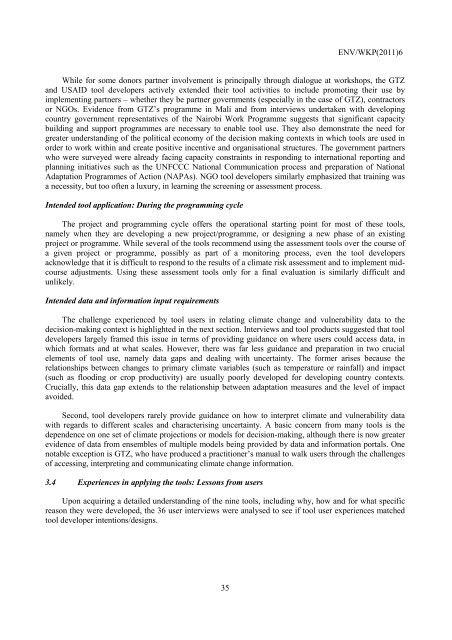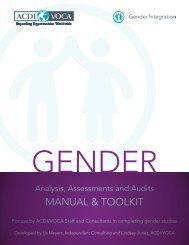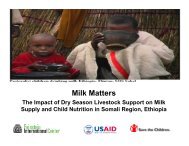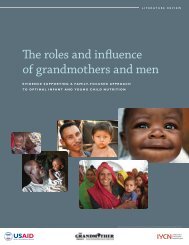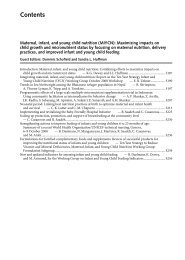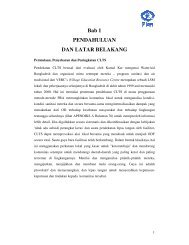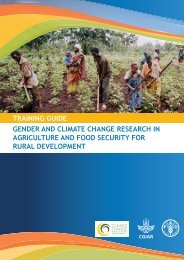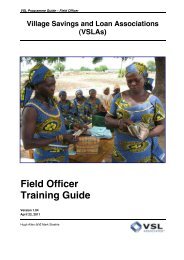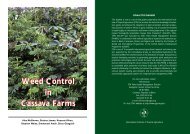Harmonising Climate Risk Management - International Institute for ...
Harmonising Climate Risk Management - International Institute for ...
Harmonising Climate Risk Management - International Institute for ...
- No tags were found...
Create successful ePaper yourself
Turn your PDF publications into a flip-book with our unique Google optimized e-Paper software.
ENV/WKP(2011)6While <strong>for</strong> some donors partner involvement is principally through dialogue at workshops, the GTZand USAID tool developers actively extended their tool activities to include promoting their use byimplementing partners – whether they be partner governments (especially in the case of GTZ), contractorsor NGOs. Evidence from GTZ’s programme in Mali and from interviews undertaken with developingcountry government representatives of the Nairobi Work Programme suggests that significant capacitybuilding and support programmes are necessary to enable tool use. They also demonstrate the need <strong>for</strong>greater understanding of the political economy of the decision making contexts in which tools are used inorder to work within and create positive incentive and organisational structures. The government partnerswho were surveyed were already facing capacity constraints in responding to international reporting andplanning initiatives such as the UNFCCC National Communication process and preparation of NationalAdaptation Programmes of Action (NAPAs). NGO tool developers similarly emphasized that training wasa necessity, but too often a luxury, in learning the screening or assessment process.Intended tool application: During the programming cycleThe project and programming cycle offers the operational starting point <strong>for</strong> most of these tools,namely when they are developing a new project/programme, or designing a new phase of an existingproject or programme. While several of the tools recommend using the assessment tools over the course ofa given project or programme, possibly as part of a monitoring process, even the tool developersacknowledge that it is difficult to respond to the results of a climate risk assessment and to implement midcourseadjustments. Using these assessment tools only <strong>for</strong> a final evaluation is similarly difficult andunlikely.Intended data and in<strong>for</strong>mation input requirementsThe challenge experienced by tool users in relating climate change and vulnerability data to thedecision-making context is highlighted in the next section. Interviews and tool products suggested that tooldevelopers largely framed this issue in terms of providing guidance on where users could access data, inwhich <strong>for</strong>mats and at what scales. However, there was far less guidance and preparation in two crucialelements of tool use, namely data gaps and dealing with uncertainty. The <strong>for</strong>mer arises because therelationships between changes to primary climate variables (such as temperature or rainfall) and impact(such as flooding or crop productivity) are usually poorly developed <strong>for</strong> developing country contexts.Crucially, this data gap extends to the relationship between adaptation measures and the level of impactavoided.Second, tool developers rarely provide guidance on how to interpret climate and vulnerability datawith regards to different scales and characterising uncertainty. A basic concern from many tools is thedependence on one set of climate projections or models <strong>for</strong> decision-making, although there is now greaterevidence of data from ensembles of multiple models being provided by data and in<strong>for</strong>mation portals. Onenotable exception is GTZ, who have produced a practitioner’s manual to walk users through the challengesof accessing, interpreting and communicating climate change in<strong>for</strong>mation.3.4 Experiences in applying the tools: Lessons from usersUpon acquiring a detailed understanding of the nine tools, including why, how and <strong>for</strong> what specificreason they were developed, the 36 user interviews were analysed to see if tool user experiences matchedtool developer intentions/designs.35


